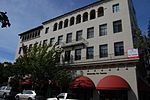Hostess House
Houses completed in 1918Houses on the National Register of Historic Places in CaliforniaNational Register of Historic Places in Santa Clara County, CaliforniaSan Francisco Bay Area Registered Historic Place stubsSanta Clara County, California geography stubs

The Hostess House is a historic house in Palo Alto, California. It was built in 1918 by the YWCA for members of the United States Army to meet their relatives while they were still serving in World War I. The Hostess House was originally located in Camp Fremont.The building operated as a hostess house from May through October 1918. The house was designed by architect Julia Morgan. It has been listed on the National Register of Historic Places since July 30, 1976. The building moved locations after World War I ended and was repurposed into a municipally sponsored community center, the first in the nation.
Excerpt from the Wikipedia article Hostess House (License: CC BY-SA 3.0, Authors, Images).Hostess House
University Avenue, Palo Alto
Geographical coordinates (GPS) Address Nearby Places Show on map
Geographical coordinates (GPS)
| Latitude | Longitude |
|---|---|
| N 37.443055555556 ° | E -122.16472222222 ° |
Address
Palo Alto Transit Center
University Avenue 95
94301 Palo Alto
California, United States
Open on Google Maps







